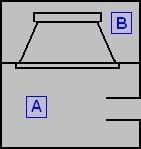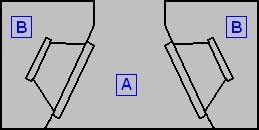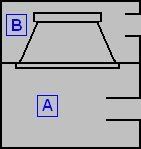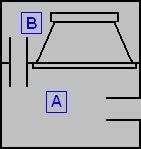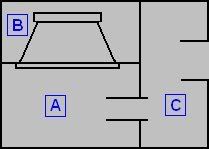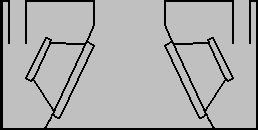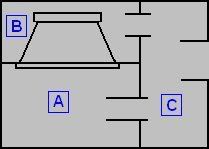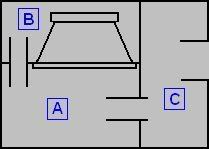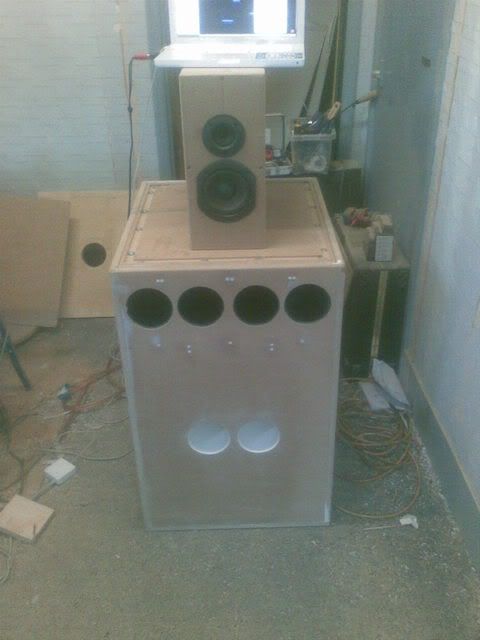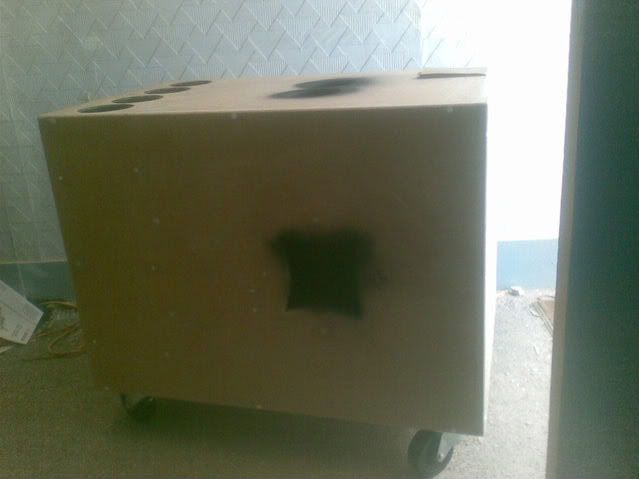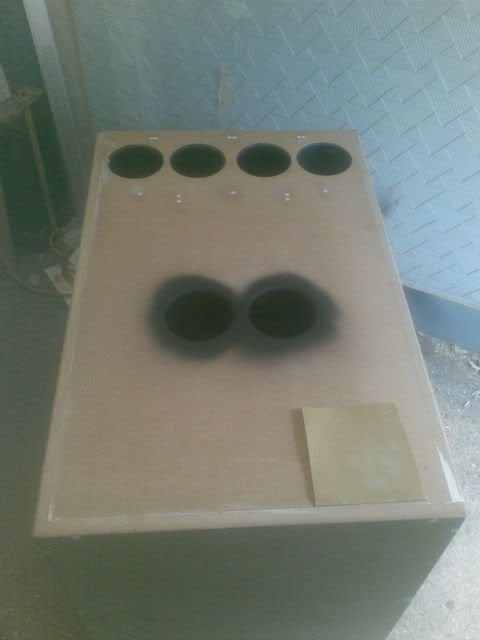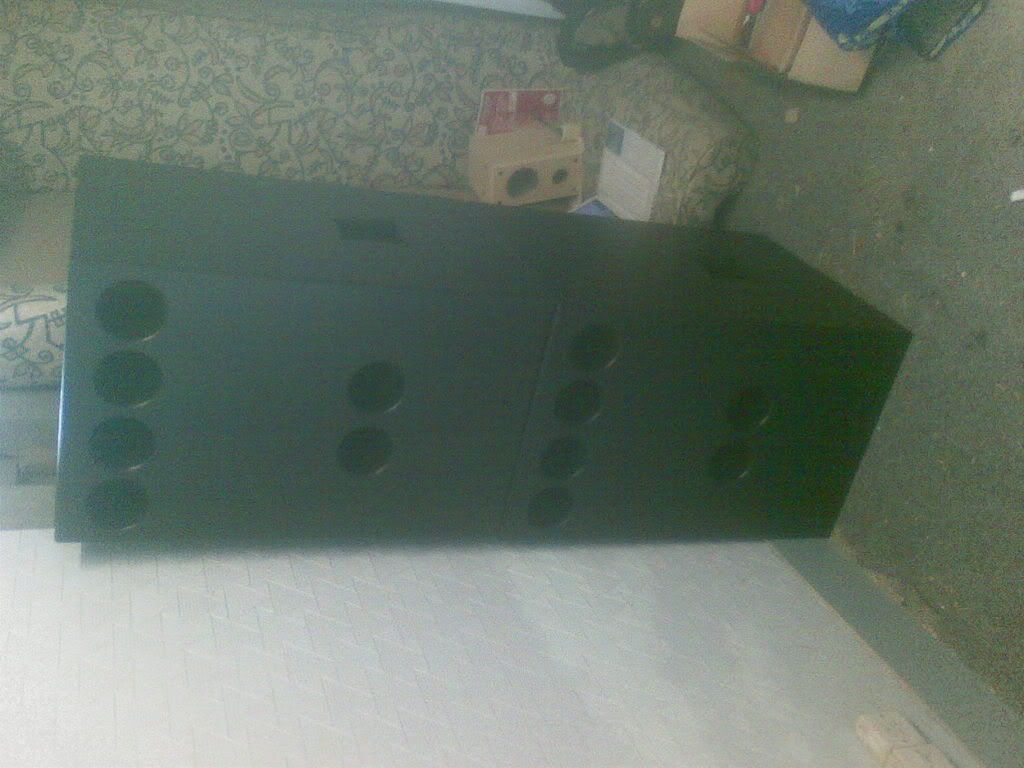- Posts: 170
- Thank you received: 0
Bandpass designs
- jake_fielder
-
 Topic Author
Topic Author
- Offline
- Elite Member
-

Less
More
17 years 6 months ago #614
by jake_fielder
Bandpass designs was created by jake_fielder
In this message I will illustratesome different bandpassdesigns....
(Thanks tojsg mashed for explaining thisto me)
Whenworking outthe order of a bandpass cab;
You get 2nd order for the driver, and 2 more orders for each chamber and portyou add on.
When the chamber behind the driver is sealed, it does not add another order.
[So the order of a sealed box "acoustic suspension" cabinet is the same as that of just the driver. This is because the compliance of the air in the chamber "merges" with the compliance of the driver and becomes one element. If you then port that chamber, you separate the two compliances because they no longer act as one. So you get an order for the port and another for the now-separate chamber volume.]
A 4th order bandpass can look like this:
The driver and sealed chamber Bare 2 orders, chamber Aand theport are a further 2 orders.
Designs like this are also 4th order bandpass:
(like the Infrabass)
The drivers and sealed rear chambers Bare 2 orders, and they fire into a chamber Aand theport which is two more orders.
Common 6th order bandpass cabs can look like this:
Parallel6th order is when(like the X1) both chambers A and B are ported to the outside
Series 6th order is when chambers B and A are ported in series IE.B is ported into chamber A which is ported to the outside.
With the two above the driver is two orders, chamber Band itsport are two more, andchamber Aand itsport are two more.
Another form of 6th order:
The driver and sealed chamber Bare 2 orders, andchambers A and Cand ports make up 4 more orders.
Designs like this are also 6th order bandpass:
Dual parallel 6th order bandpass
A couple of 8th order bandpass designs:
This one aboveis the same layout as the Mighty dub pass design.
This is like a parallel 6th order but both chambers are portedinto a third chamber C.
The 8th order above is like a series 6th order but with chamber A ported into a third chamberCinstead of tothe outside.
I'll add more to this later, obviously if anyone has anything to add, do so.
Jake
(Thanks tojsg mashed for explaining thisto me)
Whenworking outthe order of a bandpass cab;
You get 2nd order for the driver, and 2 more orders for each chamber and portyou add on.
When the chamber behind the driver is sealed, it does not add another order.
[So the order of a sealed box "acoustic suspension" cabinet is the same as that of just the driver. This is because the compliance of the air in the chamber "merges" with the compliance of the driver and becomes one element. If you then port that chamber, you separate the two compliances because they no longer act as one. So you get an order for the port and another for the now-separate chamber volume.]
A 4th order bandpass can look like this:
The driver and sealed chamber Bare 2 orders, chamber Aand theport are a further 2 orders.
Designs like this are also 4th order bandpass:
(like the Infrabass)
The drivers and sealed rear chambers Bare 2 orders, and they fire into a chamber Aand theport which is two more orders.
Common 6th order bandpass cabs can look like this:
Parallel6th order is when(like the X1) both chambers A and B are ported to the outside
Series 6th order is when chambers B and A are ported in series IE.B is ported into chamber A which is ported to the outside.
With the two above the driver is two orders, chamber Band itsport are two more, andchamber Aand itsport are two more.
Another form of 6th order:
The driver and sealed chamber Bare 2 orders, andchambers A and Cand ports make up 4 more orders.
Designs like this are also 6th order bandpass:
Dual parallel 6th order bandpass
A couple of 8th order bandpass designs:
This one aboveis the same layout as the Mighty dub pass design.
This is like a parallel 6th order but both chambers are portedinto a third chamber C.
The 8th order above is like a series 6th order but with chamber A ported into a third chamberCinstead of tothe outside.
I'll add more to this later, obviously if anyone has anything to add, do so.
Jake
Please Log in or Create an account to join the conversation.
- bee
-

- Offline
- Platinum Member
-

Less
More
- Posts: 2090
- Thank you received: 34
17 years 6 months ago #634
by bee
Replied by bee on topic Bandpass designs
Thanks jake that clears a few things up for me.
Please Log in or Create an account to join the conversation.
- dj maca roots
-

- Offline
- Junior Member
-

17 years 6 months ago #1908
by dj maca roots
Eternal Party At The End Of Time
Replied by dj maca roots on topic Bandpass designs
Nice one, any picture of projects out there for these?
Eternal Party At The End Of Time
Please Log in or Create an account to join the conversation.
- jsg
-
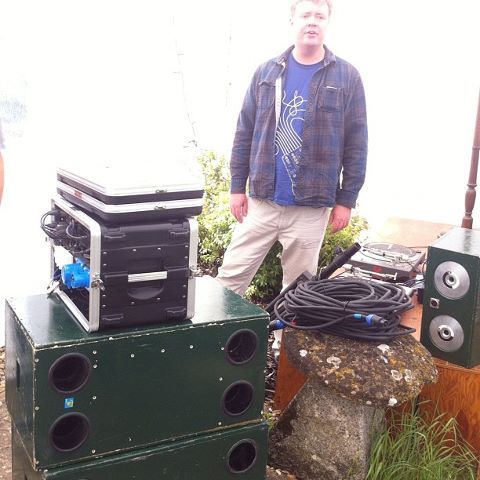
- Offline
- Elite Member
-

Less
More
- Posts: 236
- Thank you received: 0
17 years 6 months ago #1928
by jsg
I've provided plans for an 8th order cab called BPB (which is the green sub in the pictures on the shootout thread). I think the plans will appear when the main site comes up - along with some other nice plans I think.
Ars est celare artem
Replied by jsg on topic Bandpass designs
DJ Maca Roots wrote: Nice one, any picture of projects out there for these?
I've provided plans for an 8th order cab called BPB (which is the green sub in the pictures on the shootout thread). I think the plans will appear when the main site comes up - along with some other nice plans I think.
Ars est celare artem
Please Log in or Create an account to join the conversation.
- studio45
-

- Offline
- Junior Member
-

Less
More
- Posts: 28
- Thank you received: 0
17 years 6 months ago #2104
by studio45
Replied by studio45 on topic Bandpass designs
Please Log in or Create an account to join the conversation.
- dj maca roots
-

- Offline
- Junior Member
-

17 years 6 months ago #2106
by dj maca roots
Eternal Party At The End Of Time
Replied by dj maca roots on topic Bandpass designs
Looks cool.
Just started to make some Synth leads on Massive.
Good cheep Soft Synth.
Just started to make some Synth leads on Massive.
Good cheep Soft Synth.
Eternal Party At The End Of Time
Please Log in or Create an account to join the conversation.
- studio45
-

- Offline
- Junior Member
-

Less
More
- Posts: 28
- Thank you received: 0
17 years 6 months ago #2113
by studio45
Replied by studio45 on topic Bandpass designs
i was having a go on that Blue soft synth tother day, on a venue system with those EAW 2x12 horn subs. making dubstep-like bass patches with that much <60hz headroom = great fun  womwomwomwomWAWAWAWAWAWAWaaaaaaaaaaaaaaaaaaaawomwomwomwomwomwomwom.................
womwomwomwomWAWAWAWAWAWAWaaaaaaaaaaaaaaaaaaaawomwomwomwomwomwomwom.................
"hey! cut that out you're knocking my coffee off the desk upstairs!"
the F1 infrabass is a pure bandpass design aye? is it well favoured in dubstep circles?
"hey! cut that out you're knocking my coffee off the desk upstairs!"
the F1 infrabass is a pure bandpass design aye? is it well favoured in dubstep circles?
Please Log in or Create an account to join the conversation.
- dj maca roots
-

- Offline
- Junior Member
-

17 years 6 months ago #2114
by dj maca roots
Eternal Party At The End Of Time
Replied by dj maca roots on topic Bandpass designs
Cool EAW and Mackie is every where since I'm in Seattle.
Don't know about the Blue soft synth.
In Seattle One of the Clubs has 4 JBL SRX 2x18 Sounds ok.
A friend of mine sets up a KV2 VHD system that can Destroy a place in Very High Definition [img]smileys/smiley2.gif[/img]
I think people use the X1 for dubstep and like that.
Don't know about the Blue soft synth.
In Seattle One of the Clubs has 4 JBL SRX 2x18 Sounds ok.
A friend of mine sets up a KV2 VHD system that can Destroy a place in Very High Definition [img]smileys/smiley2.gif[/img]
I think people use the X1 for dubstep and like that.
Eternal Party At The End Of Time
Please Log in or Create an account to join the conversation.
- studio45
-

- Offline
- Junior Member
-

Less
More
- Posts: 28
- Thank you received: 0
17 years 5 months ago #2605
by studio45
Replied by studio45 on topic Bandpass designs
Please Log in or Create an account to join the conversation.
- dj maca roots
-

- Offline
- Junior Member
-

17 years 5 months ago #2610
by dj maca roots
Eternal Party At The End Of Time
Replied by dj maca roots on topic Bandpass designs
congrats [img]smileys/smiley32.gif[/img]
Eternal Party At The End Of Time
Please Log in or Create an account to join the conversation.
Time to create page: 0.447 seconds
